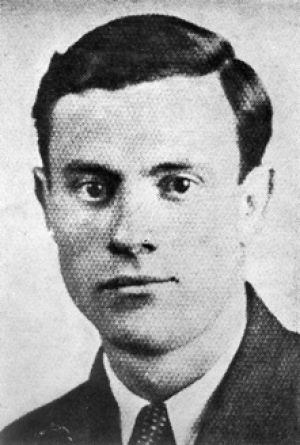Aahron Liebskind

Aharon Liebskind was born in Zabierzow, a village near Krakow in 1912, and he studied law at Krakow University. In 1938 he became secretary of the Akiva movement, which he had joined at the age of fourteen. In early 1939 he was appointed national secretary of Akiva and went to live in Warsaw, although he kept his home in Krakow as well, and continued to lead the movement there. As well as the above commitments he also managed to complete his doctoral dissertation. His job kept him in Warsaw until the outbreak of the war.
From the outset of the German occupation of Poland, Liebeskind was convinced that the Jews would not be able to live under the Nazis, and he did all he could to get the members of his movement out of Poland. Liebeskind was a charismatic figure, much admired by his fellow members and followers. He did not accept an immigration certificate to Palestine for himself, so as not to abandon his family and followers during these dark times.
In December 1940 Liebeskind was put in charge of an agricultural and vocational training programme in the Krakow area, sponsored by the Jewish Self-Help Society, which had it’s headquarters in Krakow. He utilised his position to promote the activities of the Jewish underground in the city, which he had founded and led. Using the society’s official stationery, he distributed leaflets and arranged money transfers to the members of the Underground.
Liebeskind also arranged for the financing of the Kopaliny training farm, headed by Shimshon Draenger, which served as a cover for underground operations. His post enabled him to move around and thereby to maintain and strengthen contact with fellow members in various locations. The deportation of Jews from the Krakow ghetto to the Belzec death camp in June 1942 convinced Liebeskind that the only way left was that of armed struggle, even though there was little hope of survival. He is credited with saying that, “the Jewish fighters are fighting for three lines in history.” He initiated the established of a broadly based fighting organisation in Krakow, forging ties with the other leaders of the He- Haluts (pioneer) youth organisations in the city.
An especially close tie existed between Liebeskind and Avraham Leibovich (Laban) of the Dror movement, and the two became the commanders of the resistance organisation, the Fighting Organisation of the Pioneering Jewish Youth (He-Haluts ha-Lohem). Leibovich was captured by the Germans in December 1942, was taken with other Jewish resistance fighters on the 29 April 1943 by trucks to the Plaszow Labour Camp. During the short drive from the prison to the Labour Camp they were able to escape from the truck. Most of them were murdered by machined-gun fire. Among the few who escaped being shot was Avraham Leibovich, but he was recaptured and taken to Plaszow and killed.
When the Gestapo began to pursue him, in November 1942, Liebeskind and the organisation’s headquarters moved to the “Aryan” part of the city. From there he renewed contact with the Polish Communist Workers Party (PPR) – which had been broken off in the wake of an abortive attempt made in September 1942 to leave the Krakow ghetto and take refuge in the forests – and with its Jewish unit, commanded by Heshek (Zvi) Bauminger.
Liebeskind aim was to launch a large-scale attack on the Germans inside Krakow. On the 22 December 1942, He-Haluts ha-Lohem and the Jewish unit of the PPR attacked German targets in Krakow. They inflicted many casualties on the Germans, but following the attack, the headquarters and most of the members of He-Haluts ha- Lohem fell into German hands. On the 24 December 1942 Liebeskind was caught in the headquarters bunker and killed in a hand-to-hand fight.
Source:
Encyclopaedia of the Holocaust
Sir Martin Gilbert, The Holocaust, Collins London 1986 Wiener Library Photograph – Yad Vashem© Holocaust Historical Society 2014

